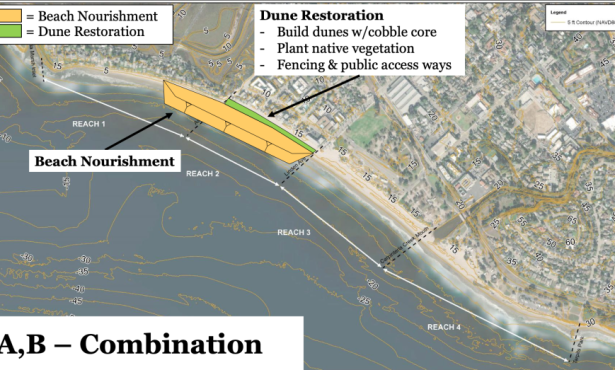Coast Guard Port Study Recommends Shipping Lane Changes to Reduce Ship Strikes of Large Whales
While supporting such proposed changes, EDC also expressed disappointment at the Coast Guard’s decision not to recommend vessel speed limits. Whale protections are in need of improvement under the current port access system, as tragically illustrated in the fall of 2007, when at least five endangered blue whales were killed as a result of collisions with ships within the Channel. The Santa Barbara Channel area hosts the densest known seasonal congregation of blues on the planet.
“We are pleased that the Coast Guard port access study recommends moving existing Santa Barbara Channel shipping lanes to separate ships from important whale feeding areas. If made, the change will help protect endangered blue, fin, and humpback whales from the threat of ship strikes,” stated Brian Segee, staff attorney for the EDC.
Specifically, the LA/LB PARS recommends that the existing separation between the shipping lanes in the Channel be narrowed from 2 nautical miles (nm) to 1 nm, allowing the inbound lane to be moved 1 nm to the north, away from the “shelf edge” habitat where blue and other whale species congregate to feed on upwellings of krill. The Coast Guard is proposing this action because it “may help to reduce the number of ship strikes on whales.”
The LA/LB PARS was catalyzed by shipping industry efforts to avoid compliance with a recent California Air Resources Board (CARB) rule requiring large ocean going vessels to burn clean, low-sulfur fuels within 24 nautical miles of the California coast, a zone that encompasses the entirety of the Santa Barbara Channel shipping lanes. Instead of complying with this rule, many ships have been traveling on the south side of the Channel Islands through what has been termed the “western approach.” This western approach runs through the heart of the Point Mugu Sea Range, where the Navy conducts hundreds of live fire and training exercises each year, causing a potential public safety issue. In response to this issue, the LA/LB PARS recommends that formal shipping lanes also be created on the south side of the islands in order to provide predictability and reduce conflicts.
EDC has encouraged the Coast Guard to use the LA/LB PARS as an opportunity to address ship strikes since initiation of the process in April 2010. In August 2010, EDC published the article “Whale of an Opportunity” in U.C. Berkeley’s Ecology Law Currents, arguing that the PARS could be used to provide overdue protections to whales in the channel. (available at: http://elq.typepad.com/currents/2010/08/currents37-07-segee-2010-0816.html#more).
In our comments on the PARS, EDC also recommended that the Coast Guard consider a required reduction in ship speed, in order to further protect whales from collisions with large vessels. “In addition to moving the shipping lanes, we support mandatory speed limits so that whales are less likely to be hurt or killed by a collision with a ship,” said Segee. “Slower ship speeds will also reduce air pollution, noise and greenhouse gas emissions.”
In response to EDC’s request for ship speed limits, the Coast Guard noted that the authority to impose speed restrictions rests with the National Oceanic and Atmospheric Administration (NOAA). EDC and three other environmental groups (Center for Biological Diversity, Friends of the Earth and Pacific Environment) filed a petition with NOAA in May, 2011, requesting the agency to impose a 10 knot speed limit on ships traveling through the four California national marine sanctuaries.
The Coast Guard’s authority to designate traffic separation schemes is provided by the Ports and Waterways Safety Act (PWSA). Enacted in the wake of the 1967 grounding of the oil supertanker Torrey Canyon in the English Channel, the PWSA’s two primary goals are “navigation and vessel safety,” and “protection of the marine environment.” The PWSA mandates that the Coast Guard conduct an open and transparent public process in conducting its Port Access Route Study, and specifically directs the agency to consult with a broad range of stakeholders, including environmental groups. Before the recommendation in the PARS can be implemented, the Coast Guard will need to initiate a formal public rule-making process.


